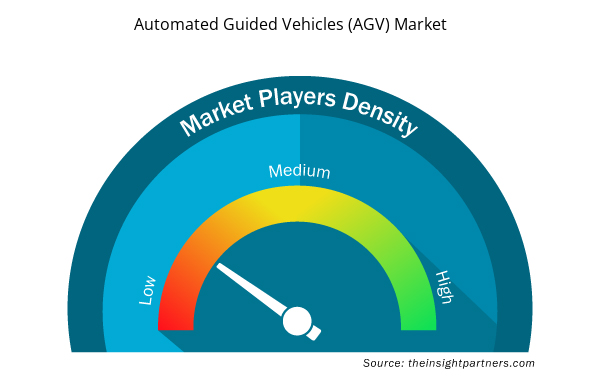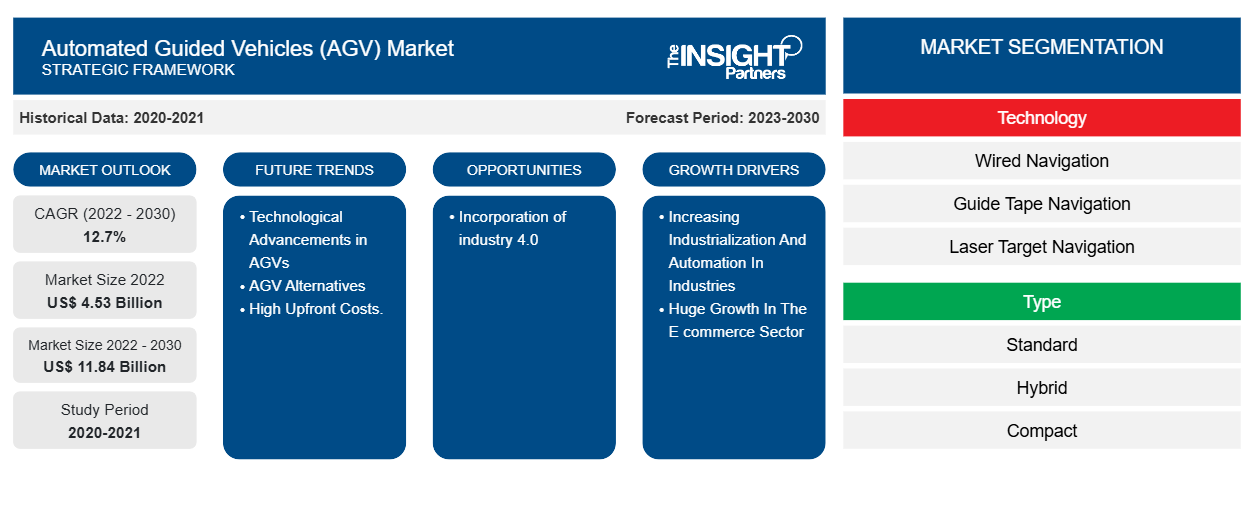[調査レポート] 無人搬送車(AGV)市場規模は、2022年の45億3,000万米ドルから2030年には118億4,000万米ドルに達すると予想されており、2022年から2030年までのCAGRは12.7%と推定されています。
アナリストの視点:
無人搬送車(AGV)市場を牽引する主な要因の1つは、自動化とインダストリー4.0における進行中の革命です。産業界がデジタル化とスマート製造プロセスを採用するにつれて、AGVを既存のシステムに統合することは、生産と物流のワークフローを最適化するための論理的なステップになります。AGVは他の機械やソフトウェアシステムとシームレスに接続できるため、同期された合理化された操作が可能になり、生産性とスループットが向上します。インダストリー4.0は、倉庫で人間とロボットが効率的に連携できる運用環境の構築も目指しています。たとえば、ドイツポストDHLグループ内の契約物流リーダーであるDHLサプライチェーンは、倉庫でのピッキングにAGVとロボットを使用しています。同社は、オランダの産業オートメーション企業であるロボモーティブと協力して、デパレタイズ、ピッキング、注文処理機能を備えたロボットセルを開発しました。多様な製品カタログ、競争力のある価格設定、買い物のしやすさなどの要因により、消費者の間でeコマースの人気が高まっています。電子商取引は、AmazonやWalmartなどの大手企業の存在により、先進国と新興国で急速に成長しています。電子商取引の人気の高まりにより、倉庫と配送センターの需要が急増しています。その結果、電子商取引小売の需要の増加が、無人搬送車(AGV)市場の成長をさらに促進しています。
自動誘導車両(AGV)市場の概要:
自動誘導車両 (AGV) 市場は、絶え間ない技術の進歩と、効率的で費用対効果の高い材料処理ソリューションに対する需要の高まりにより、大幅な成長を遂げています。AGV は、産業および商業環境内で移動して材料を輸送できる自動運転の無人車両であり、手作業の必要性を排除し、人的ミスを減らします。自動誘導車両 (AGV) 市場の成長を後押しするもう 1 つの要因は、さまざまな業界で安全性と効率性がますます重視されていることです。AGV には高度なセンサー、カメラ、衝突回避技術が搭載されており、事故や物品の損傷を起こすことなく複雑な環境を移動できます。これらの機能により、AGV は安全基準の向上を目指す業界にとって魅力的な選択肢となっています。
自動誘導車両(AGV)市場の推進要因:
工業化と自動化の進展により自動搬送車(AGV)市場が成長
工業化と自動化は、世界中の企業や産業の運営方法に革命をもたらしています。自動化により、企業は労働集約的なタスクを排除し、生産の精度と速度を向上させることで、コスト効率と効率性を高めることができました。自動化には、製品の品質を向上させ、人的ミスを減らす可能性もあります。これにより、企業は顧客サービスを改善し、業務を近代化し、顧客の待ち時間を短縮できました。自動化は、企業がより柔軟になり、市場の変化に迅速に対応できるようにするのにも役立ちます。企業が自動化を採用すると、それが業務にもたらすメリットをすぐに実感します。産業における工業化と自動化は大幅に増加しています。たとえば、2023年6月、ロックウェル・オートメーションは、自動車メーカーの85%がテクノロジーの採用により従業員を維持または増加させる計画であると発表しました。さらに、64%の企業がプロセスを自動化するためにソフトウェアを使用しており、54%のリーダーが労働力不足に対処するために自動化を増やしています。無人搬送車は、安全性の向上、生産時間の短縮、生産量の確保、人的ミスのリスクの最小化など、さまざまな目的で広く使用されています。したがって、産業における工業化と自動化の進展が自動誘導車両 (AGV) 市場を牽引しています。AGV) market.
要件に合わせてレポートをカスタマイズする
このレポートの一部、国レベルの分析、Excelデータパックなど、あらゆるレポートを無料でカスタマイズできます。また、スタートアップや大学向けのお得なオファーや割引もご利用いただけます。
- このレポートの主要な市場動向を入手してください。この無料サンプルには、市場動向から見積もりや予測に至るまでのデータ分析が含まれます。
レポートのセグメンテーションと範囲:
「無人搬送車(AGV)市場」は、技術、車両タイプ、エンドユーザー、および地域に基づいてセグメント化されています。技術に基づいて、無人搬送車(AGV)市場は、レーザーターゲットナビゲーション、磁気ナビゲーション、有線ナビゲーション、ガイドテープナビゲーションなどに分かれています。車両タイプ別の無人搬送車(AGV)市場は、牽引車、パレットトラック、タガートレイン、フォークリフトトラックなどに分かれています。エンドユーザーに基づいて、無人搬送車(AGV)市場は、物流、自動車、一般製造、ヘルスケア、小売、食品および飲料、航空宇宙などに分かれています。地理に基づいて、無人搬送車(AGV)市場は、北米、ヨーロッパ、アジア太平洋、中東およびアフリカ、南米に分かれています。
自動誘導車両(AGV)市場セグメント分析:
技術に基づいて、無人搬送車(AGV)市場は、有線ナビゲーション、ガイドテープナビゲーション、レーザーターゲットナビゲーション、マグネットナビゲーションなどに細分化されています。レーザーターゲットナビゲーションセグメントは、2022年に最大のシェアを占めました。同じセグメントは、予測期間中に無人搬送車(AGV)市場で最高のCAGRを記録すると予想されています。無人搬送車(AGV)のレーザーターゲットナビゲーション方法は非常に柔軟性が高く、さまざまな環境で使用できます。反射ターゲットを床、壁、またはその他の表面に配置できるため、AGVは障害物を回避したり、狭い通路を移動したりできます。レーザーターゲットナビゲーションは、小型カートから大型フォークリフトまで、幅広いAGVに対応するように拡張できます。これにより、さまざまな倉庫や製造アプリケーションに汎用的なソリューションになります。さまざまなメーカーが、レーザーターゲットナビゲーションシステムを搭載した無人搬送車を発売しています。
無人搬送車(AGV)市場の地域分析:
北米の無人搬送車(AGV)市場規模は2022年に11億6,116万米ドルと評価され、2030年までに29億7,690万米ドルに達すると予測されています。また、2023年から2030年の間に12.5%のCAGRを記録すると予想されています。北米の無人搬送車(AGV)市場は、米国、カナダ、メキシコに分割されています。米国は2022年に北米の無人搬送車(AGV)市場で最大のシェアを占めました。米国の製造企業は、新技術の採用により生産性を高めることで、今後数年間で急成長することを計画しています。さらに、ガソリン価格の低下、新興市場での人件費の上昇、企業の知的財産権を保護する規制の枠組みの改善が、成長を後押ししています。米国の企業は、生産性を高め、サービス提供市場での競争上の優位性を獲得するために、自動化されたマテリアルハンドリングソリューションを導入しています。金属、食品・飲料、倉庫、ライフサイエンス、半導体・電子機器製造業界の企業では、自社施設内に自動化された資材搬送設備を導入するケースが増えています。新しい電気自動車や自動運転車メーカーが米国に製造施設を開設しています。
自動誘導車両(AGV)市場の主要プレーヤー分析:
無人搬送車 (AGV) 市場は、Dematic Corp、Kion Group AG、Jungheinrich AG、Toyota Material Handling Inc、Konecranes Plc、John Bean Technologies Corp、Daifuku Co Ltd、Bastian Solutions LLC、Hyster-Yale Group Inc、Murata Machinery Ltd などの企業で構成されています。
無人搬送車
無人搬送車(AGV)市場の地域別分析
予測期間を通じて自動誘導車両 (AGV) 市場に影響を与える地域的な傾向と要因は、Insight Partners のアナリストによって徹底的に説明されています。このセクションでは、北米、ヨーロッパ、アジア太平洋、中東およびアフリカ、南米および中米にわたる自動誘導車両 (AGV) 市場のセグメントと地理についても説明します。

- 無人搬送車(AGV)市場の地域別データを入手
自動誘導車両(AGV)市場レポートの範囲
| レポート属性 | 詳細 |
|---|---|
| 2022年の市場規模 | 45億3千万米ドル |
| 2030年までの市場規模 | 118.4億米ドル |
| 世界のCAGR(2022年 - 2030年) | 12.7% |
| 履歴データ | 2020-2021 |
| 予測期間 | 2023-2030 |
| 対象セグメント | テクノロジー別
|
| 対象地域と国 | 北米
|
| 市場リーダーと主要企業プロフィール |
|
無人搬送車(AGV)市場のプレーヤー密度:ビジネスダイナミクスへの影響を理解する
無人搬送車 (AGV) 市場は、消費者の嗜好の変化、技術の進歩、製品の利点に対する認識の高まりなどの要因により、エンドユーザーの需要が高まり、急速に成長しています。需要が高まるにつれて、企業は提供を拡大し、消費者のニーズを満たすために革新し、新たなトレンドを活用し、市場の成長をさらに促進しています。
市場プレーヤー密度とは、特定の市場または業界内で活動している企業または会社の分布を指します。これは、特定の市場スペースに、その市場規模または総市場価値に対してどれだけの競合相手 (市場プレーヤー) が存在するかを示します。
無人搬送車(AGV)市場で事業を展開している主要企業は次のとおりです。
- デマティック社
- キオングループAG
- ユンハインリッヒAG
- トヨタマテリアルハンドリング株式会社
- コネクレーンズ
免責事項:上記の企業は、特定の順序でランク付けされていません。

- 自動誘導車両(AGV)市場のトップキープレーヤーの概要を入手
最近の動向:
合併や買収などの無機的および有機的な戦略は、自動誘導車両 (AGV) 市場の企業で広く採用されています。自動誘導車両 (AGV) 市場の最近の主要な動向をいくつか以下に示します。
- 2023 年 6 月、Dematic は最新の冷凍庫対応自律走行車 (AGV) を発表しました。ハイリーチ モデルやカウンターバランス モデルを含む Dematic の AGV の全製品ラインは、オーストラリアで設計および製造されました。現在、凍結環境での使用が完全に認定されており、成長する自律走行車 (AGV) 市場のニーズに応えています。
- 2023 年 3 月、Storage Solutions グループ (以下「Storage Solutions」) は、Merit Capital Partners、MFG Partners、および Storage Solutions の経営陣から Jungheinrich AG に買収されました。米国の合併管理認可を含むすべての完了要件が満たされています。Storage Solutions により、Jungheinrich は堅固な成長基盤をもって、米国のラックおよび倉庫自動化市場を拡大します。
- 2021年12月、KIONグループは中国に新しいフォークリフト工場を開設し、さらなるサプライチェーンソリューション工場の礎を築きました。これらの新しい施設は、KIONグループが中国での成長戦略を推し進め、両方の事業セグメントで製品ポートフォリオを拡大するのに役立ちます。KIONグループは、中期的に済南で1,000人以上の新規雇用を創出する計画です。KIONグループの約4万人の従業員のうち、4,600人以上がすでに中国を拠点としています。
- 過去2年間の分析、基準年、CAGRによる予測(7年間)
- PEST分析とSWOT分析
- 市場規模価値/数量 - 世界、地域、国
- 業界と競争環境
- Excel データセット



Report Coverage
Revenue forecast, Company Analysis, Industry landscape, Growth factors, and Trends

Segment Covered
This text is related
to segments covered.

Regional Scope
North America, Europe, Asia Pacific, Middle East & Africa, South & Central America

Country Scope
This text is related
to country scope.
よくある質問
The global automated guided vehicles (AGV) market is expected to reach US$ 11.84 billion by 2030.
The incremental growth expected to be recorded for the global automated guided vehicles (AGV) market during the forecast period is US$ 7.31 billion.
The increasing industrialization and automation in industries, huge growth in the e-commerce sector, and increasing need for well-managed operations in warehouses, distribution, and manufacturing facilities are the major factors that propel the global automated guided vehicles (AGV) market.
The global automated guided vehicles (AGV) market was estimated to be US$ 4.53 billion in 2022 and is expected to grow at a CAGR of 12.7 % during the forecast period 2023 - 2030.
Technological advancements in AGVs are impacting the automated guided vehicles (AGV), which is anticipated to play a significant role in the global automated guided vehicles (AGV) market in the coming years.
The key players holding majority shares in the global automated guided vehicles (AGV) market are Toyota Material Handling Inc, Kuka, Kion Group AG, Hyster-Yale Group Inc, and Daifuku Co Ltd.
Trends and growth analysis reports related to Electronics and Semiconductor : READ MORE..
The List of Companies - Automated Guided Vehicles (AGV) Market
- Dematic Corp
- Kion Group AG
- Jungheinrich AG
- Toyota Material Handling Inc
- Konecranes Plc
- John Bean Technologies Corp
- Daifuku Co Ltd
- Bastian Solutions LLC
- Hyster-Yale Group Inc
- Murata Machinery Ltd
The Insight Partners performs research in 4 major stages: Data Collection & Secondary Research, Primary Research, Data Analysis and Data Triangulation & Final Review.
- Data Collection and Secondary Research:
As a market research and consulting firm operating from a decade, we have published and advised several client across the globe. First step for any study will start with an assessment of currently available data and insights from existing reports. Further, historical and current market information is collected from Investor Presentations, Annual Reports, SEC Filings, etc., and other information related to company’s performance and market positioning are gathered from Paid Databases (Factiva, Hoovers, and Reuters) and various other publications available in public domain.
Several associations trade associates, technical forums, institutes, societies and organization are accessed to gain technical as well as market related insights through their publications such as research papers, blogs and press releases related to the studies are referred to get cues about the market. Further, white papers, journals, magazines, and other news articles published in last 3 years are scrutinized and analyzed to understand the current market trends.
- Primary Research:
The primarily interview analysis comprise of data obtained from industry participants interview and answers to survey questions gathered by in-house primary team.
For primary research, interviews are conducted with industry experts/CEOs/Marketing Managers/VPs/Subject Matter Experts from both demand and supply side to get a 360-degree view of the market. The primary team conducts several interviews based on the complexity of the markets to understand the various market trends and dynamics which makes research more credible and precise.
A typical research interview fulfils the following functions:
- Provides first-hand information on the market size, market trends, growth trends, competitive landscape, and outlook
- Validates and strengthens in-house secondary research findings
- Develops the analysis team’s expertise and market understanding
Primary research involves email interactions and telephone interviews for each market, category, segment, and sub-segment across geographies. The participants who typically take part in such a process include, but are not limited to:
- Industry participants: VPs, business development managers, market intelligence managers and national sales managers
- Outside experts: Valuation experts, research analysts and key opinion leaders specializing in the electronics and semiconductor industry.
Below is the breakup of our primary respondents by company, designation, and region:

Once we receive the confirmation from primary research sources or primary respondents, we finalize the base year market estimation and forecast the data as per the macroeconomic and microeconomic factors assessed during data collection.
- Data Analysis:
Once data is validated through both secondary as well as primary respondents, we finalize the market estimations by hypothesis formulation and factor analysis at regional and country level.
- Macro-Economic Factor Analysis:
We analyse macroeconomic indicators such the gross domestic product (GDP), increase in the demand for goods and services across industries, technological advancement, regional economic growth, governmental policies, the influence of COVID-19, PEST analysis, and other aspects. This analysis aids in setting benchmarks for various nations/regions and approximating market splits. Additionally, the general trend of the aforementioned components aid in determining the market's development possibilities.
- Country Level Data:
Various factors that are especially aligned to the country are taken into account to determine the market size for a certain area and country, including the presence of vendors, such as headquarters and offices, the country's GDP, demand patterns, and industry growth. To comprehend the market dynamics for the nation, a number of growth variables, inhibitors, application areas, and current market trends are researched. The aforementioned elements aid in determining the country's overall market's growth potential.
- Company Profile:
The “Table of Contents” is formulated by listing and analyzing more than 25 - 30 companies operating in the market ecosystem across geographies. However, we profile only 10 companies as a standard practice in our syndicate reports. These 10 companies comprise leading, emerging, and regional players. Nonetheless, our analysis is not restricted to the 10 listed companies, we also analyze other companies present in the market to develop a holistic view and understand the prevailing trends. The “Company Profiles” section in the report covers key facts, business description, products & services, financial information, SWOT analysis, and key developments. The financial information presented is extracted from the annual reports and official documents of the publicly listed companies. Upon collecting the information for the sections of respective companies, we verify them via various primary sources and then compile the data in respective company profiles. The company level information helps us in deriving the base number as well as in forecasting the market size.
- Developing Base Number:
Aggregation of sales statistics (2020-2022) and macro-economic factor, and other secondary and primary research insights are utilized to arrive at base number and related market shares for 2022. The data gaps are identified in this step and relevant market data is analyzed, collected from paid primary interviews or databases. On finalizing the base year market size, forecasts are developed on the basis of macro-economic, industry and market growth factors and company level analysis.
- Data Triangulation and Final Review:
The market findings and base year market size calculations are validated from supply as well as demand side. Demand side validations are based on macro-economic factor analysis and benchmarks for respective regions and countries. In case of supply side validations, revenues of major companies are estimated (in case not available) based on industry benchmark, approximate number of employees, product portfolio, and primary interviews revenues are gathered. Further revenue from target product/service segment is assessed to avoid overshooting of market statistics. In case of heavy deviations between supply and demand side values, all thes steps are repeated to achieve synchronization.
We follow an iterative model, wherein we share our research findings with Subject Matter Experts (SME’s) and Key Opinion Leaders (KOLs) until consensus view of the market is not formulated – this model negates any drastic deviation in the opinions of experts. Only validated and universally acceptable research findings are quoted in our reports.
We have important check points that we use to validate our research findings – which we call – data triangulation, where we validate the information, we generate from secondary sources with primary interviews and then we re-validate with our internal data bases and Subject matter experts. This comprehensive model enables us to deliver high quality, reliable data in shortest possible time.


 このレポートの無料サンプルを入手する
このレポートの無料サンプルを入手する